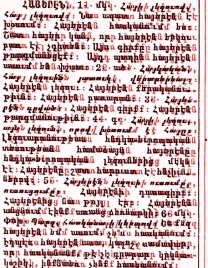Armenian language
Tuesday, November 23, 2021
Armenian is an Indo-European language belonging to an independent branch of which it is the only member. It is the official language of Armenia. Historically spoken in the Armenian Highlands, today Armenian is widely spoken throughout the Armenian diaspora. Armenian is written in its own writing system, the Armenian alphabet, introduced in 405 AD by the priest Mesrop Mashtots. The total number of Armenian speakers worldwide is estimated between 5 and 7 million.
Armenian is an independent branch of the Indo-European languages. It is of interest to linguists for its distinctive phonological developments within that family. Armenian exhibits more satemization than centumization, although it is not classified as belonging to either of these subgroups. Some linguists tentatively conclude that Armenian, Greek (and Phrygian) and Indo-Iranian were dialectally close to each other; within this hypothetical dialect group, Proto-Armenian was situated between Proto-Greek (centum subgroup) and Proto-Indo-Iranian (satem subgroup). Ronald I. Kim has noted unique morphological developments connecting Armenian to Balto-Slavic languages.
Armenia was a monolingual country by the 2nd century BC at the latest. Its language has a long literary history, with a 5th-century Bible translation as its oldest surviving text. Its vocabulary has historically been influenced by Western Middle Iranian languages, particularly Parthian; its derivational morphology and syntax were also affected by language contact with Parthian, but to a lesser extent. Contact with Greek, Persian, and Syriac also resulted in a number of loanwords. There are two standardized modern literary forms, Eastern Armenian and Western Armenian, with which most contemporary dialects are mutually intelligible.
Although Armenians were known to history much earlier (for example, they were mentioned in the 6th-century BC Behistun Inscription and in Xenophon's 4th century BC history, The Anabasis), the oldest surviving Armenian-language text is the 5th century AD Bible translation of Mesrop Mashtots, who created the Armenian alphabet in 405, at which time it had 36 letters. He is also credited by some with the creation of the Georgian alphabet and the Caucasian Albanian alphabet.
While Armenian constitutes the sole member of the Armenian branch of the Indo-European family, Aram Kossian has suggested that the hypothetical Mushki language may have been a (now extinct) Armenic language.





